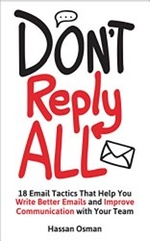Don’t Reply All: 18 Email Tactics That Help You Write Better Emails and Improve Communication with Your Team, by Hassan Osman
Don’t Reply All: 18 Email Tactics That Help You Write Better Emails and Improve Communication with Your Team, by Hassan Osman
Hassan Osman has a vast experience managing projects with large, geographically distributed teams. His previous book, Influencing Virtual Teams, offered no-nonsense tactics to help you managing your team.
Despite the huge advances in communications and the little improvement in email systems, email is here to stay. And it makes sense, because email remains one of the most effective and frictionless form of communications.
Reading, writing, and answering emails consumes a significant amount of everybody’s time. According to a 2012 McKinsey study cited by Osman, the average US worker spends 28% of his/her workweek reading and responding to email. Most people recognize that they should do something about how they deal with mail, the actual number of people taking some real action is small.
This book is not about managing your inbox –no “inbox zero” pretentions here–, but about down-to-earth tactics to help you and your team become better and more effective communicators. The value of the book is not in its novelty –“There’s nothing earth-shattering about the contents of this book. In fact, many of my tips are common sense that you’ve probably read somewhere before”– but in that it offers proven best practices that you can adopt immediately, and that you can share with your team immediately.
The tactics described in Don’t Reply All can be divided in two groups, tactics 1 to 5 being the most important and effective ones. “If you take away a handful of lessons from this entire book, they should be those five tactics. They are your 80/ 20—the 20% of actions that will produce 80% of your results.”
These 5 tactics are about how to write meaninful subject lines, keeping the content of your emails short and to the point, and assigning tasks using the “3W"s:
- The Who. Use the name of a single person of the name of the persons, don’t address people using “all”, “team”, etc.
- The What. Don’t be ambiguous and avoid making assumptions.
- The When. The exact time and date a task needs to be completed by. Always use a deadline, even if it’s fake.
The remaining 13 tactics in the book cover other no-nonsense advice like why you should steer away from asking open-ended questions in mails, how to use delayed delivery for sending emails when they are most likely to be read, and the maybe the most important one: do not hit reply-all when only the original sender needs to read your message.
I think that anybody whose work involves using email for communicating with coworkers and clients will greatly benefit from the tactics offered in this book.

